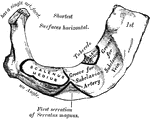Clipart tagged: ‘Facet’

Anthropod
This is a diagram illustrating the compound eye of anthropods. A, the whole eye shown in section; B,…
Eleventh Rib
The eleventh and twelfth ribs have each a single articular facet on the head, which is of rather large…

First Rib
The first rib is the shortest and the most curved of all the ribs; it is broad and flat, its surfaces…

Second Rib
The second rib is much longer than the first, but bears a very considerable resemblance to it in the…
Twelfth Rib
The eleventh and twelfth ribs have each a single articular facet on the head, which is of rather large…